Feeling Whimsy |
|
 |
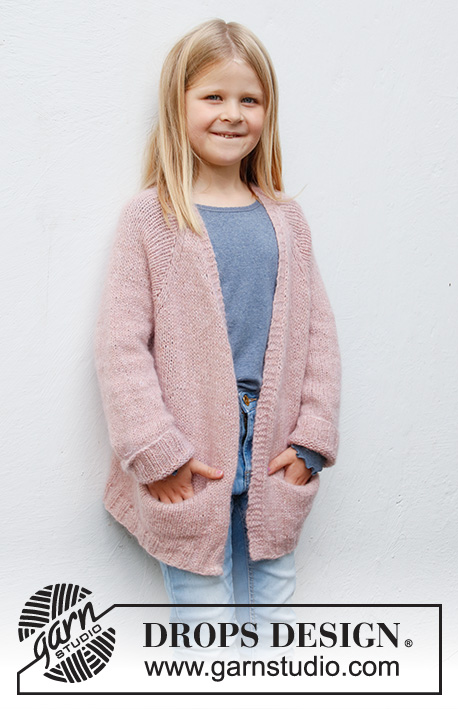 |
Knitted jacket for children in DROPS Sky and DROPS Kid-Silk. The piece is worked top down, with raglan and pockets. Sizes 3 to 14 years.
DROPS Baby & Children 38-19 |
|
|
------------------------------------------------------- EXPLANATIONS FOR THE PATTERN: ------------------------------------------------------- RIDGE/GARTER STITCH (worked back and forth): Knit all rows. 1 ridge in height = Knit 2 rows. INCREASE TIP (evenly spaced): To work out how to increase evenly, count the total number of stitches on the needle (e.g. 110 stitches) minus the bands (e.g. 10 stitches) and divide the remaining stitches by the number of increases to be made (e.g. 10) = 10. In this example, increase by making 1 yarn over after each 10th stitch. Do not increase on the bands. On the next row (wrong side) purl the yarn overs twisted to avoid holes. RAGLAN: All increases are worked from the right side! Increase to raglan in each transition between body and sleeves as follows: Work until there is 1 stitch left before marker thread, 1 yarn over, knit 2 (marker thread sits between these 2 stitches), 1 yarn over (= 2 stitches increased). On the next row (wrong side) purl the yarn overs twisted to avoid holes. Then work the new stitches in stocking stitch. A total of 8 stitches are increased on each increase-row. V-NECK: All increases are worked from the right side! Make 1 yarn over inside the 5 band stitches and knit 1 (= 1 stitch increased on both sides). On the next row (wrong side) purl the yarn overs twisted to avoid holes. Then work the new stitches in stocking stitch. A total of 2 stitches increased on each increase-row). DECREASE TIP (for sleeves): Decrease 1 stitch on either side of the marker thread as follows: Work until there are 3 stitches left before the marker thread, knit 2 together, knit 2 (marker thread sits between these 2 stitches), slip 1 stitch as if to knit, knit 1 and pass the slipped stitch over the knitted stitch. CASTING-OFF TIP: To avoid the cast-off edge being tight you can cast off with a larger size needle. If the edge is still tight, make 1 yarn over after approx. each 6th stitch at the same time as casting off; the yarn overs are cast off as normal stitches. ------------------------------------------------- START THE PIECE HERE: ------------------------------------------------------- JACKET – SHORT OVERVIEW OF THE PIECE: The 2 pockets are worked first and will be worked into the piece later. Then you work 2 collar-pieces, which are then placed on circular needle when casting on stitches for the neck, as described in the text (the collar-pieces are sewn together mid-back and to the back of the neck to finish). The yoke is continued back and forth with circular needle, from mid front and top down. AT THE SAME TIME stitches are increased for the V-neck and for raglan. The yoke is divided for the body and sleeves and the body continued back and forth with circular needle, then the pockets are continued. The sleeves are worked in the round with double pointed needles/short circular needle, top down. POCKETS (first half): Cast on 22-22-24-24-26-26 stitches (including 1 edge stitch on each side) with needle size 5.5 mm and 1 strand Sky and 1 strand Kid-Silk (= 2 strands). Work stocking stitch with 1 edge stitch in GARTER STITCH – read description above, on each side. REMEMBER THE KNITTING TENSION! When the piece measures 8-8-8-10-10-10 cm cast off both edge stitches = 20-20-22-22-24-24 stitches. Place the stitches on 1 thread. Work 1 more pocket in the same way. Lay them to one side. The other half of the pockets are worked and assembled to finish. COLLAR: Cast on 5 stitches with needle size 5.5 mm and 1 strand Sky and 1 strand Kid-Silk (= 2 strands) and work garter stitch back and forth (row 1 = right side) for 8-8-8-10-11-11 cm. Cut the strand and lay the collar to one side. Work 1 more collar in the same way. Place the second collar-piece on circular needle size 5.5 mm without cutting the strand, cast on 36-36-36-46-48-48 stitches and then knit the 5 stitches from the first collar-piece = 46-46-46-56-58-58 stitches. Purl 1 row from the wrong side over all stitches. Work the yoke as described below. YOKE: READ THE WHOLE SECTION BEFORE CONTINUING! Place 4 markers in the piece without working the stitches as follows: Count 7 stitches (= front piece), insert 1 marker before the next stitch, count 8-8-8-12-12-12 stitches (= sleeve), insert 1 marker before the next stitch, count 16-16-16-18-20-20 stitches (= back piece), insert 1 marker before the next stitch, count 8-8-8-12-12-12 stitches (= sleeve), insert 1 marker before the next stitch. There are 7 stitches left after the last marker in all sizes (= front piece). Continue with stocking stitch and 5 band stitches in garter stitch on each side towards mid front – AT THE SAME TIME on the first row from the right side, increase to RAGLAN in each transition between body and sleeves – read description above. Increase to raglan every 2nd row (i.e. each row from the right side) a total of 14-16-16-17-17-18 times. AT THE SAME TIME on row 4 (i.e. 2nd row from the right side) increase to V-NECK on each side towards mid front – read description above, as follows: Increase every 4th row a total of 6-6-7-7-8-8 times. After the last increase to raglan and after all increases for neck are worked the piece measures approx. 16-19-19-20-20-21 cm from the cast-on edge and there are 170-186-188-206-210-218 stitches. The next row is worked as follows from the wrong side: Work the first 27-29-30-31-32-33 stitches as before (= front piece), place the next 36-40-40-46-46-48 stitches on 1 thread for the sleeve, cast on 6-6-8-8-8-10 stitches (= in side under sleeve), purl 44-48-48-52-54-56 (= back piece), place the next 36-40-40-46-46-48 stitches on 1 thread for the sleeve, cast on 6-6-8-8-8-10 stitches (= in side under sleeve) and work the last 27-29-30-31-32-33 stitches as before (= front piece). Body and sleeves are finished separately. THE PIECE IS NOW MEASURED FROM HERE! BODY: = 110-118-124-130-134-142 stitches. Continue with stocking stitch and 5 band stitches in garter stitch on each side. When the piece measures approx. 13-14-18-18-21-23 cm from the division, work the next row from the right side as follows: Work the first 11-11-11-13-13-13 stitches, place the next 20-20-22-22-24-24 stitches on 1 thread (the other half of the pocket will be worked here later), work the 20-20-22-22-24-24 stitches from the one pocket (make sure you continue on the right side of the pocket), work until there are 31-31-33-35-37-37 stitches left on the row, place the next 20-20-22-22-24-24 stitches on 1 thread, work the 20-20-22-22-24-24 stitches from the other pocket (make sure you continue on the right side of the pocket) and work the last 11-11-11-13-13-13 stitches. Continue with stocking stitch and 5 band stitches in garter stitch on each side. When the piece measures 21-22-26-28-31-33 cm from the division, knit 1 row from the right side where you increase 10-10-12-14-14-14 stitches evenly spaced – read INCREASE TIP = 120-128-136-144-148-156 stitches. Purl 1 row from the wrong side (bands worked in garter stitch). Change to circular needle size 4.5 mm and work the next row from the right side as follows: 5 band stitches in garter stitch, * knit 2, purl 2 *, work from *-* until there are 7 stitches left, knit 2 and 5 band stitches in garter stitch. Continue this rib for 6 cm. Loosely cast off with garter stitch over garter stitch, knit over knit and purl over purl – read CASTING-OFF TIP! The jacket measures approx. 46-50-54-58-61-64 cm from the shoulder down. SLEEVES: Place the 36-40-40-46-46-48 stitches from the thread on the one side of the piece on double pointed needles/short circular needle size 5.5 mm and knit up 1 stitch in each of the 6-6-8-8-8-10 stitches cast on under the sleeve = 42-46-48-54-54-58 stitches. Insert a marker thread in the middle of the new stitches under the sleeve. Start the round at the marker thread and work stocking stitch in the round. When the sleeve measures 3 cm from the division, decrease 2 stitches mid-under the sleeve – read DECREASE TIP. Decrease like this every 3-3-3½-3-3½-3½ cm a total of 6-7-7-10-9-10 times = 30-32-34-34-36-38 stitches. Continue working without further increases, until the sleeve measures 23-25-30-33-38-42 cm from the division. There is approx. 6 cm left to finished length; try the jacket on and work to desired length. Knit 1 round where you increase 6-8-6-10-8-10 stitches evenly spaced = 36-40-40-44-44-48 stitches. Change to double pointed needles size 4.5 mm and work rib (knit 2, purl 2) for 4 cm. Cast off with knit over knit and purl over purl – remember CASTING-OFF TIP! The sleeve measures approx. 29-31-36-39-44-48 cm from the division. Work the other sleeve in the same way. POCKETS: Worked back and forth. Place the 20-20-22-22-24-24 stitches from the thread on the right front piece on circular needle size 5.5 mm. On the first row cast on 1 edge stitch on each side = 22-22-24-24-26-26 stitches. Work stocking stitch with 1 edge stitch in garter stitch on each side until the pocket measures 8-8-8-10-10-10 cm, loosely cast off. Work the pocket on the left front piece in the same way. ASSEMBLY: Sew the pockets together, inside the 1 edge stitch. Then fasten to the inside of the jacket with small, neat stitches in each of the bottom corners (should not be visible on the right side). Sew the collar together at the back, with the seam on the wrong side. Stretch the collar slightly and sew it to the neckline at the back. |
|
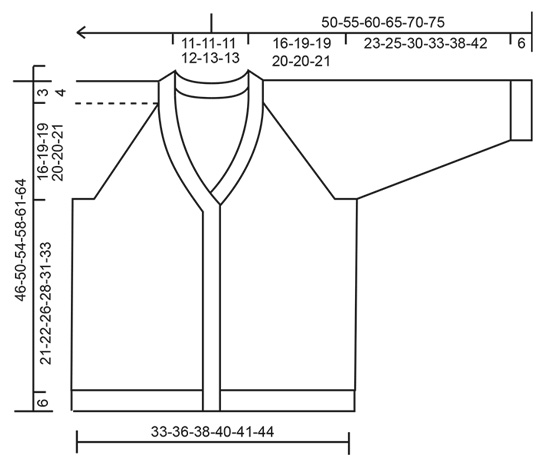
|
|
|
Have you made this or any other of our designs? Tag your pictures in social media with #dropsdesign so we can see them! Do you need help with this pattern?You'll find tutorial videos, a Comments/Questions area and more by visiting the pattern on garnstudio.com. © 1982-2024 DROPS Design A/S. We reserve all rights. This document, including all its sub-sections, has copyrights. Read more about what you can do with our patterns at the bottom of each pattern on our site. |
|







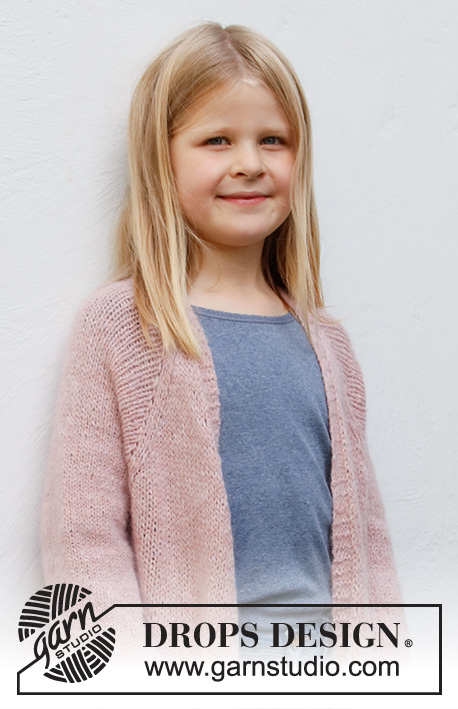
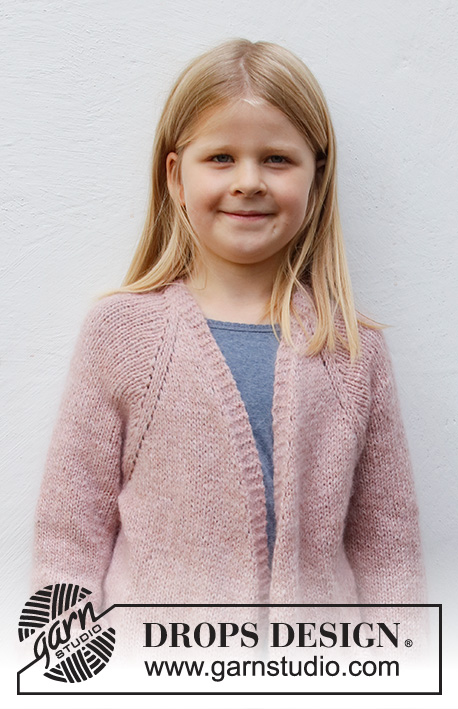
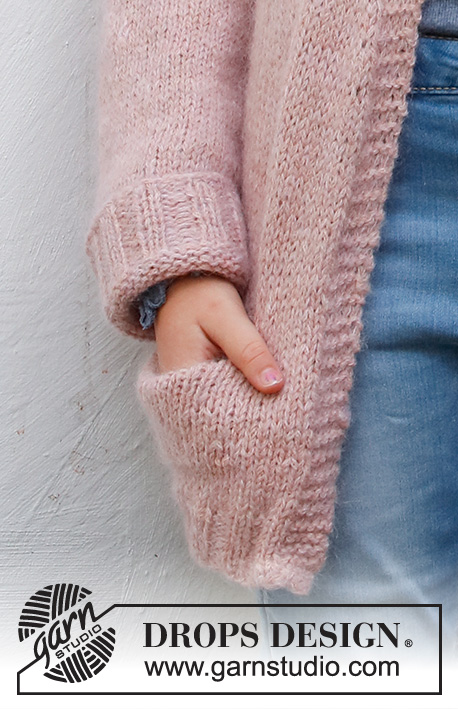

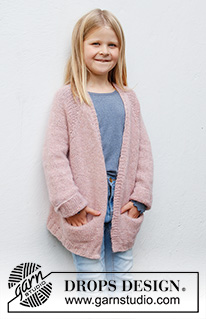
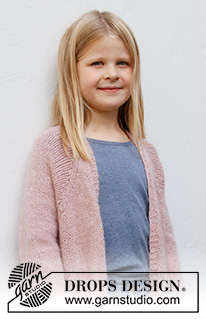
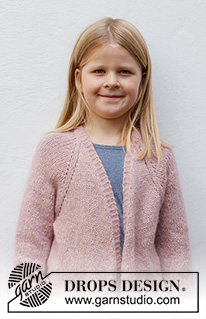
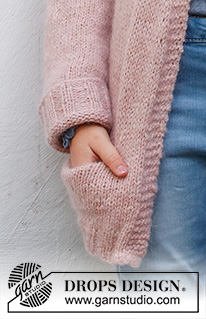







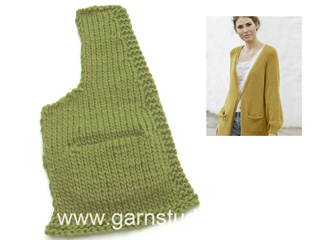



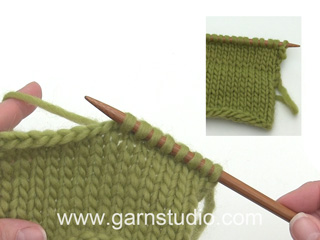







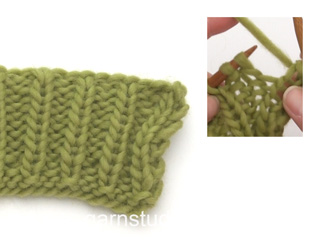

























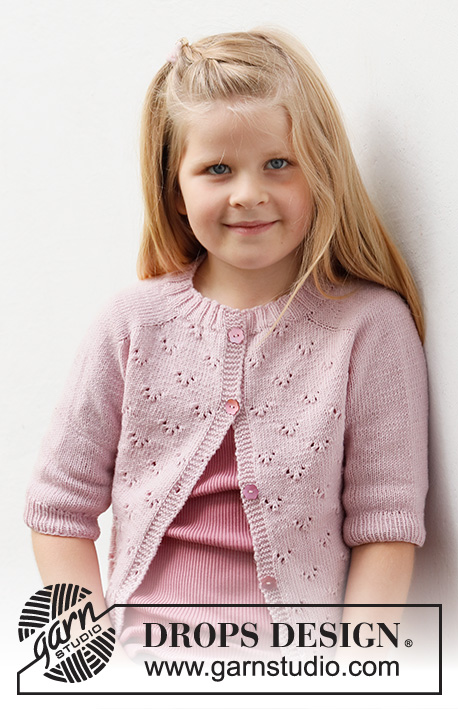






Comments / Questions (37)
Bonsoir, Merci pour ce joli modèle, que je viens de commencer. Je procède peu à peu aux augmentations raglan et de l'encolure, mais le col tricoté au début ressemble à deux petites pattes étranges sur les côtés dont je ne vois guère, malgré les explications finales, comment elles pourraient devenir un col... Merci beaucoup !
12.11.2022 - 21:41DROPS Design answered:
Bonjour Manoa, les deux parties du col tricotées au tout début seront ensuite assemblées entre elles le long de leur rang de montage puis cousues le long de l'encolure dos (sous ASSEMBLAGE). Bon tricot!
14.11.2022 - 10:41Jag förstår inte hur jag ska få ihop fickorna med själva koftan.
05.10.2022 - 18:09DROPS Design answered:
Hei Annika. Ta en titt på denne videoen: Hur man stickar en lös ficka på insidan av ett plagg mvh DROPS Design
10.10.2022 - 11:20Hallo liebes Drops-Team, mit welcher Nadelstärke wurde die Maschenprobe gestrickt? Danke und VG
18.08.2022 - 12:52DROPS Design answered:
Liebe Laura, benutzen Sie die grösseren Nadeln, dh di Rundnadel Nr 5,5 für die Maschenprobe für das Glattrechte Teil. Viel Spaß beim stricken!
18.08.2022 - 15:05Gibt es eine Anleitung der Jacke für Erwachsene oder eine entsprechende Tabelle, wie ich es selber ausrechnen könnte? Lieben Dank für die Antwort.
14.07.2022 - 14:09DROPS Design answered:
Liebe Katharina, eine Tabelle zum Umrechnen können wir Ihnen leider nicht bieten. Schauen Sie doch einfach mal bei den Damen-Anleitungen für DROPS Sky, ob Sie dort eine Jacke finden, die Ihnen ebenso gut (oder sogar noch besser? ;-)) gefällt. Viel Spaß beim Stöbern!
18.07.2022 - 13:30Hallo Drops Team Eine Frage zum Rumpfteil nach dem Raglan: Warum werden die Maschen für den Rücken links gestrickt?
08.03.2022 - 20:15DROPS Design answered:
Liebe Frau Scharnetzki, meinen Sie bei der Verteilung? Diese Reihe ist eine Rückreihe, so werden alle Maschen links gestrickt (nur die Blenden-Maschen werden bei der Rückreihen rechts gestrickt). Viel Spaß beim stricken!
08.03.2022 - 22:18Hvordan færdiggør man forkant og nakke?
01.02.2022 - 16:15DROPS Design answered:
Hej Ingrid, du starter med halskanterne... hvis du skriver mere nøjagtig hvor er du i opskriften og hvilken størrelse du strikker, så kan vi prøve at hjælpe dig :)
03.02.2022 - 15:53Hej, Jag har problem med stickfastheten. Har nu gjort oket som ska blir i storlek 7-8 år 19 cm och mitt ok är 13 cm. Såg att det var fler som haft samma problem. Kan jag bara fortsätta och sticka tills det blir 19 cm eller blir det fel när jag inte gör några ökningar? Tack, Annika
09.01.2022 - 08:39Mir ist nicht klar, wie die Taschen funktionieren. Bilden die angestrickten Teile zusammen eine Tasche, die unten zusammen genäht wird und dann quasi innen frei schwingt und an den Ecken fixiert wird? D.h. die im Rumpfteil angestrickte Taschenhälfte wird eingeklappt und bildet die Vorderseite der innen hängenden Tasche und der Teil, der an die stillgelegten 20 M gestrickt wird, bildet den hinteren Teil der innen liegenden Tasche? Oder ganz anders?
27.12.2021 - 23:11DROPS Design answered:
Liebe Heike, dieses Video zeigt, wie man solche Taschen strickt. Hoffentlich kann es Ihnen helfen. Viel Spaß beim stricken!
03.01.2022 - 09:19Goedemorgen, ik ben dit leuke vest aan het breien in maat 9/10 jaar. Echter, naar mijn idee klopt op de tekening het aantal centimeters niet. Onderaan is de afstand 40 cm. Helft is 20 cm. Bovenaan wordt aangegeven, vanaf middenachter: 6 (helft opzet) +20+33+6=65 cm. Tot zover klopt het. Als ik echter de mouwlengte (33+6=) 39 cm eraf trek houd ik geen 20 (is helft onderbreedte), maar 26 cm over. Waar komt die extra 6 cm vandaan? Alvast bedankt voor de reactie, vriendelijke groet, Anneke Schutte
22.12.2021 - 09:40DROPS Design answered:
Dag Anneke,
De mouw schuift a.h.w. een stukje in de oksel, ik denk dat hier het verschil van 6 cm vandaan komt.
13.02.2022 - 10:04Point fantaisie 1j 2mes mon travaille par de biae
15.11.2021 - 11:45DROPS Design answered:
Bonjour Mme Gilbert, je suis désolée, je ne comprends pas votre question, pourriez-vous reformuler s'il vous plaît? Merci d'avance!
15.11.2021 - 13:02